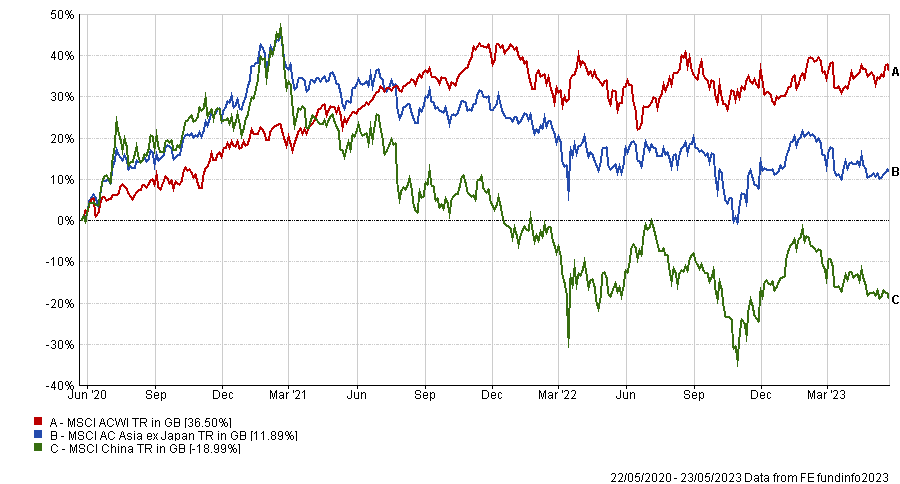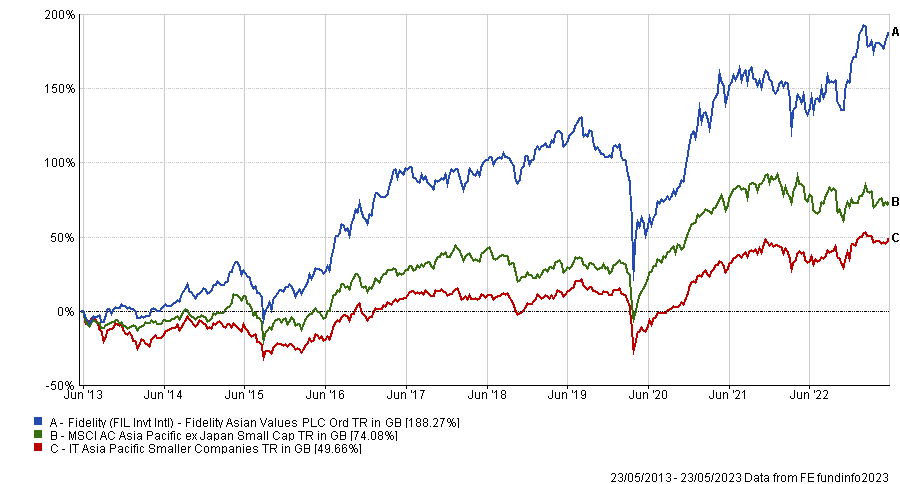China has gone through a tough period since the outbreak of Covid-19, which left the domestic market “uninvestible” to many, according to Fidelity investment director Catherine Yeung.
Over three years, the MSCI China index dropped 19%, while the MSCI ACWI gained 36.5% and the broader MSCI AC Asia ex Japan index rose 11.9%.
Unlike others, she remains confident that China will turn around but warned that there is nuance in the market now that investors need to take into account.
Total return of indices over 3yrs

Source: FE Analytics
Perhaps the nadir for sentiment towards China came last year, when Yeung said it was viewed “like India in 2012 and the US in 2008 – no one wanted to go near it… everyone was pricing in total doomsday in terms of sentiment as well as multiples.”
During this time, Fidelity Asian Values trust FE fundinfo Alpha Manager Nitin Bajaj had his largest overweight to China, with the country accounting for around 35% of the portfolio.
This has reduced slightly to 30% as of the end of March and come down further to around 28% since, according to Yeung.
Both are still overweight relative to the 10.5% allocation of the MSCI All Country Asia ex Japan Small Cap index which the trust is benchmarked against, meaning it has held a larger allocation to the country for more than two years.
Bajaj has made some profit-taking moves as Chinese equities have started to recover, in particular his exposure to Covid winners. Part of this is price, but there are also reasons to be fearful at present, which may have also been a factor.
The abrupt reopening of the economy, which took place in recent months, is an example of this. Yeung said fund managers at Fidelity believed it was “too aggressive and too quick”.
“We knew that at some point China had to reopen, but the way the government did it was not the same way as in Hong Kong, for example, where the policy was tweaked,” she noted, which made the manager “uncomfortable”.
Another is that some believe China’s economic growth model is unsustainable – something the Fidelity investment director did not necessarily disagree with.
“I think the market has built in way too many expectations. I think a rebasing [in growth expectations] is tangible and required for where we are in the cycle and what the government wants to achieve,” she said.
There are also signs for optimism, however, with Yeung outlining three potential bright spots for China. The first is the consumer, which now has deeper pockets after years of not being able to go out and spend during the protracted lockdowns in the country.
“It all comes down to willingness and ability. The latter is there as household savings are around 35%, but we haven’t seen rapid spending, so willingness needs to improve,” she said.
The second is the much-maligned property market. Here, state-owned enterprises (SEO) are gaining market share and weaker companies are being pushed out of the market, which should give confidence and drive growth.
Lastly, the impact of both domestic and foreign investment cannot be understated, but this will only be possible through better quality companies, she argued, although the lower prices on offer could attract new investors to the market.
“Relative to the rest of the region, China is still looking attractive for opportunities as well as valuations,” Yeung said.
When investing in China, Bajaj looks for three things in his small-cap trust. The first is the products or services being delivered and whether there is long-term growth.
“As an example, during the early days of Covid he owned a pool toy company and the sales went through the roof because everyone was living at home,” Yeung said.
“When we saw the company, it was still looking at having the same demand over the medium term, which was unrealistic. He hates blue-sky scenarios. Just because something is a trend now, it doesn’t mean it will be in three years.”
The second is the quality of the management team, while the third is the price, as the portfolio is made up of value stocks.
Total return of fund vs sector and benchmark over 10yrs

Source: FE Analytics
This approach has worked well, with the trust the best performer of the three portfolios in the IT Asia Pacific Smaller Companies sector, climbing 188.3% over 10 years and also beating rivals in more recent times despite the overweight to China.
One area that has served him well is SOEs, an area that many avoid. Indeed, Yeung said these SOEs were up 70% more than their privately-owned rivals over the past two years.
These firms have benefited from the introduction of key performance indicators (KPIs) set out by the government, which include focusing on return on equity and return on invested capital, rather than the previous goal of profit, which should benefit shareholders.
“Most people don’t like SOEs because they are not growthy and are in the old economy sectors but the opportunity in terms of dividend yields has been very attractive and unrecognised,” said Yeung.





